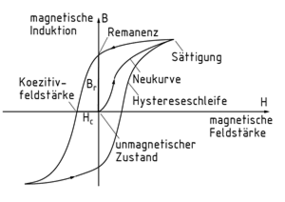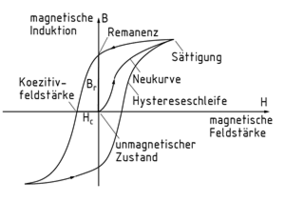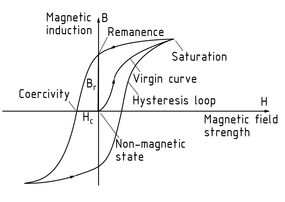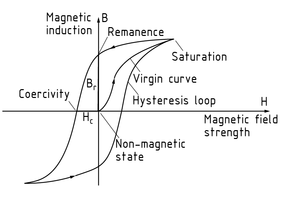
Choose one
or multiple languages
0,1,1
- German
- English
- Chinese
- Spanish
Hysteresis (electrical engineering)

Hysteresis is the term used to describe the behaviour of a system in which the output quantity depends on both the external parameters acting on the system and the previous state of the system. As a result, even when external conditions are identical, the system can still assume different values, depending on the previous state.
Hysteresis is depicted by a hysteresis curve.
For example, applying a voltage to the Transformer coil for the first time magnetises the Iron core (virgin curve). Reducing the current and thus the field Strength to 0, and then changing its polarity, causes the curve to pass the points of remanence (at H=0) and coercivity (B=0) to the point of saturation. Following a subsequent further change in polarity, the curve runs centrosymmetrically to the point of magnetisation already described.
Hysterese (Elektrotechnik)

Hysterese beschreibt ein Systemverhalten, bei dem die Ausgangsgröße neben den äußerlich einwirkenden Parametern des Systems auch von seinem vorherigen Zustand abhängig ist. Das System kann folglich bei identischen äußeren Zuständen je nach vorhergehendem Zustand unterschiedliche Werte einnehmen.
Beschrieben wird die Hysterese durch die Hysteresekurve.
Legt man z. B. an die Transformatorspule erstmalig eine Spannung an, so magnetisiert sich der Eisenkern (Neukurve). Verringert man den Strom und damit die Feldstärke auf 0 und polt ihn anschließend um, durchläuft die Kurve die Remanenz (bei H=0) und die Koerzitivfeldstärke (B=0) bis zur Sättigung. Bei anschließender Umpolung verläuft die Kurve punktsymmetrisch zur bereits beschriebenen Magnetisierung.
滞后(电气工程)

术语滞后用于描述输出量取决于作用于系统的外部参数和系统的先前状态的系统行为。因此即使当外部条件是相同的,由于先前的状态仍然可以假定该系统具有不同的值。
滞后通过滞后曲线描述。
例如,首次施加电压到变压器线圈上,铁芯被磁化(起始曲线)。减少电流直至磁场强度为0,然后再改变其极性,曲线传递剩磁感应 (H=0) 和矫顽磁性 (B=0) 直至磁性饱和。随后进一步改变极性,曲线与已经描述的磁化强度点中心对称。
磁性铁芯的磁滞回线路径
近义词
滞后曲线
起始曲线
剩磁感应
Histéresis (ingeniería eléctrica)

La histéresis es el término que se usa para describir el comportamiento de un sistema en el cual la cantidad de salida depende tanto de los parámetros externos que actúan en el sistema como del estado previo del sistema. Como resultado, incluso cuando las condiciones externas sean idénticas, el sistema aún puede asumir diferentes valores, dependiendo del estado previo.
La histéresis es representada por una curva de histéresis.
Por ejemplo, al aplicar un voltaje a una bobina de transformador por primera vez se magnetiza el núcleo de hierro (curva virgen). Reducir la corriente y, de este modo, la intensidad de campo a 0 y luego cambiar la polaridad hace que la curva pase por los puntos de remanencia (en H=0) y coercividad (B=0) hasta el punto de saturación. Siguiendo un cambio subsecuente en la polaridad, la curva pasa centrosimétricamente al punto de magnetización ya descrito.
Ruta del bucle de histéresis del núcleo de hierro magnético
